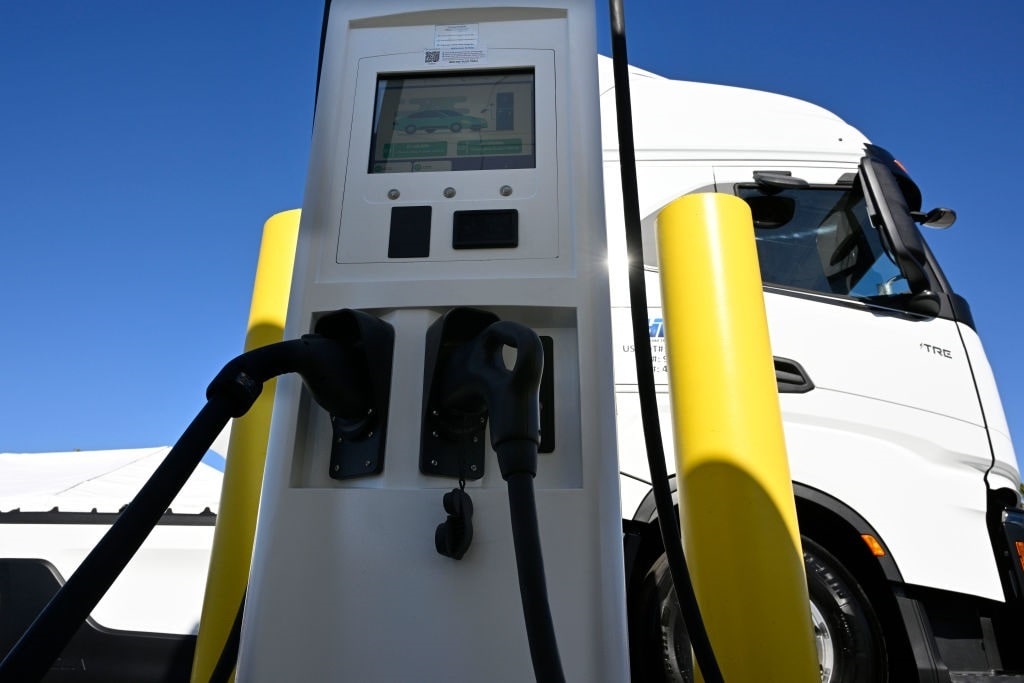
California has led the nation in a climate-saving push for EV tractor-trailer trucks to replace diesel power. Fiction eventually runs aground on reality, in this case the economic, environmental, and scientific facts that were ignored by the California Legislature when it implemented impossible mandates for gleaming fleets of EV trucks. Despite glowing visions of clean power, transitioning the nation’s semi fleet to EVs could simultaneously bankrupt the country financially and the Earth environmentally.
The Golden State’s ambitious 2022 regulatory mandates require all new cars, trucks, and SUVs sold in the region to produce “zero” emissions by 2035. Many states have followed suit, adding massive federal subsidy carrots and EPA tailpipe emission sticks. The illusion that these vehicles create “zero” emissions is rapidly dissolving as the environmental impacts of manufacturing and disposal are considered. Even if EVs were climate-saving rather than climate-destroying, the economic and logistical limitations of these fantastical mandates guarantee there will be no comprehensive EV truck fleet in California by 2035 – and probably never.
A Sisyphian Plan
California’s hasty collage of environmental policies falters on several inconvenient but insurmountable truths. The electric grid cannot handle the load. The input materials required to comply with the mandates cannot be procured. The astronomical costs are economy-destroying. And when the true expenses of externalized pollution are calculated, EV trucks do not measure up to promised environmental gains.
The nation’s electric grid, a necessary infrastructure to charge the new EV semis, is fragile,
insufficient to carry the additional burden and competes with other
growing demands for electricity from data centers and renewables
manufacturing facilities. Energy is required to source and mine the
material to build the trucks, energize them on the road, and break them
down to reclaim the materials at disposal. Heavy batteries reduce
truck-carrying capacity, meaning many more EV trucks are required to
replace an equal fleet capacity of diesel vehicles – more trucks, more
energy, and more clogged freeways. If actually achieved, California’s
plan would increase electricity demand just for EV trucks by an
estimated 57%. A single truck charging station is predicted to draw as
much electricity as 5,000 homes.
The manufacturing inputs necessary to construct imagined EV trucks were apparently ignored when California lawmakers decided to run the economy by fantasy. Much like mandating universal incomes without economic resources, EV truck fleets cannot be magically created from thin air and a rosy pipe dream. A study by the American Transportation Research Institute (ATRI) suggests that implementing California’s plan nationally (as envisioned by the Biden administration and the multi-state regulatory push for implementation) would require “tens of millions of tons of cobalt, graphite, lithium and nickel … that would take as much as 35 years at current global production rates and nearly 65% of global reserves of these minerals.” That’s a lot of mining and transportation – the rare earth industry had better get truckin’!
Unaffordable Diktats
Economic reality is mathematically grounding despite vain technocratic visions. The costs of all those rare materials mean the price of an EV truck is approximately double that of a traditional semi and the per-mile energy cost once on the road. Truck fleets operating on slim margins will have to spike rates sharply just to break even. Rates for all electric customers will skyrocket precipitously: The California Public Utility Commission increased electric rates for the state’s largest utility by 13% in 2023 (half of the 26% revenue increase requested by the utility to meet infrastructure needs).
The inflationary impacts of this EV truck boondoggle have gone unconsidered, but the impacts on consumers will be enormous. To install the charging stations for EV trucks alone would cost the nation an estimated $35 billion. Perhaps California will incur that debt to augment its current massive deficit, but the US deficit is already bloated by the oxymoronically monikered Inflation Reduction Act, which was largely a grocery list of renewable energy and EV spending projects. The fact that non-renewable, coal-plant-dependent, polluting EVs are profoundly regressive and disproportionately burden working-class Americans does not bode well for economic health.
EV Trucks Have No Clothes
The list of insurmountable realities that evaded California’s naked emperors in fashioning pie-in-the-sky EV truck mandates demonstrates that ideological whimsy, no matter how sincere, cannot overcome reality: The impossible fantasy pollutes more than it saves.
A 2023 study by the Manhattan Institute determined that EVs require far more upfront emissions to manufacture than conventional vehicles, that many modern gasoline-powered engines emit very little particulate matter, and that EVs burn through tire rubber much faster. These problems are amplified when applied to trucks (or tractors). The ubiquitous cacophony that EVs necessarily reduce carbon emissions is in serious doubt. The study notes:
“Accurately estimating the actual quantities of specific fuels used is complicated by the labyrinth of global suppliers and the lack of transparency with many of the companies. Without knowing all that, no one knows the ultimate real-world emissions from making an EV…
“The realistic potential of 43 tons of upstream emissions combined with operating realities of 24 tons of downstream emissions (over a vehicle lifetime) yields a total of 67 tons of EV CO2. This is 15% more than the 59-ton baseline for a comparable gasoline-fueled SUV.”
The inconvenient paradox of California’s mandates for EV trucks is that they likely do not spare the planet more carbon dioxide – let alone the toxins spewed from mines, the lithium batteries with no plan for recycling or disposal, the flickering electric grid, or the plunging of the marginalized into deeper marginalization.
It is to be hoped that in view of the myriad real-life impediments blocking their best-fantasized plans, EV emperors will glance in the mirror and pick up some fig leaves.
No comments:
Post a Comment